Article by Judith Vallette // Aug. 14, 2020
Danielle Brathwaite-Shirley is a London- and Berlin-based Black trans artist, game developer and mother. Through video game aesthetics and technologies, Brathwaite-Shirley aims to bring to the forefront the experiences of Black trans women and, more generally, to archive the Black trans experience. Her recent project ‘the BlackTransArchive’ is presented in the form of a video game, designed in collaboration with Black trans coders and artists as a way to fight against the erasure of their history. Brathwaite-Shirley warns against trans tourism in her work, as well as the harmful underrepresentation of Black trans narratives. In doing so, she ensures that the Black and trans people who enter her virtually-created world on the archive are given a safe space, dedicated to themselves. She does this by presenting a series of initial questions to the user, which then designate the parameters of their interaction and accessibility to the content, depending on their identity and the levels of privilege they are afforded.
We spoke to Brathwaite-Shirley about her creative process and the thinking behind ‘the BlackTransArchive.’ She also shared insights into her upcoming projects and spoke about her desire to constantly seek new collaborations and to create more participatory works. Through her art practice and activism, Brathwaite-Shirley calls to attention the lack of visibility for Black trans people in mainstream culture, as well as the everyday racism, colorism and discrimination in Berlin and beyond.
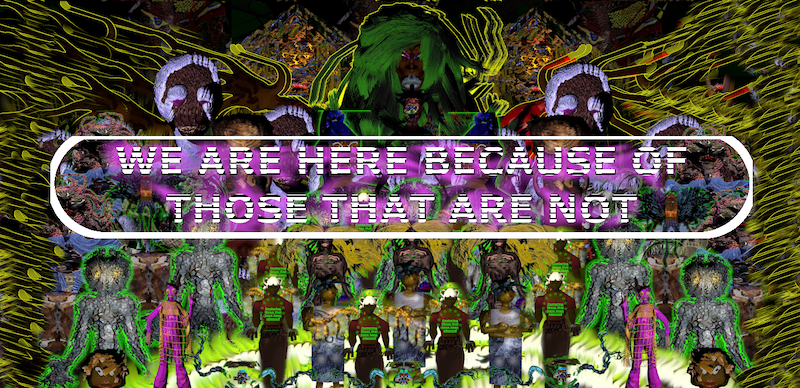
Danielle Brathwaite-Shirley: ‘We are here because of those that are not/Blacktransarchive.com,’ 2020 // Courtesy the artist
Judith Vallette: What was the impetus for using video game design as an aesthetic and artistic tool for getting across your political message in your project ‘the BlackTransArchive’? How did your passion for video game design, coding and video editing develop?
Danielle Brathwaite-Shirley: In ‘the BlackTransArchive’ I used the idea of choice because I really wanted the experience for the player to be unique and dependent on what they chose. The work I’ve made before has been for a Black trans audience but, because there wasn’t the advantage of choosing your identity, often people would come and just enjoy the work without thinking anything of themselves. I really wanted to put the viewer in the hot seat, making them notice their identity as well as making their identity determine accessibility and view-ability of the archive.
I’ve always been into video games, it’s been a very informative part of my life. I’m really into these old Playstation 1 PSX retro kind of aesthetics. I find it quite quick to work with and also the lower poly-graphics allow me to focus more on getting something across: I can quickly come up with a concept, figures and a scene to imbue it with what I really want to talk about, like Black trans life or the story of a Black trans person. All the textures in my games are usually made of images of Black people and images of Black trans people like our hands, our feet, our hair. I then manipulate those images to make something that looks like grass, a hair texture or a bio texture to imbue the 3D Earth with an archive-like layer. Perhaps the viewer won’t even recognize this but the point is that this archive of Black trans people is there throughout all the layers of the film, not just in the forefront but also in the background of the scenes.
I’ve always wanted to make a video game and before I was able to I would make these videos of video game scenarios, there’s one called ‘UnArchived Adventures.’ You could almost call them concept videos because you could see the mouse, the gameplay within them, but it was all a film. There used to be these false choices in the film that would pop out but you couldn’t choose them as they were pre-determined. The more I made of those, the more I felt I needed to make a game specifically where someone’s identity determines what happens next, so they feel responsible for the next scene they are seeing. This is where my passion for video gaming came from, that and playing Telltale’s ‘The Walking Dead’. This game is a series in an episodic form where every choice you make carries on to each episode and each game, so by the time you finish all four games you have a personalized story; you feel so guilty for the person who has died or the child you have brought up and the rest of the choices you have made while playing. I wanted to imbue this idea that you are responsible for what is happening, what you see and what you will hear. Another reason I made video games is because I didn’t see any Black trans people. I was searching for video games with trans representations and I only found a few—like ‘2064: Read Only Memories’—but there was really no Black trans representation that centred on our stories. I really wanted to create something like that and make it super accessible online so everyone can see it. It’s not just about the video game existing but it being unashamedly for Black trans people.
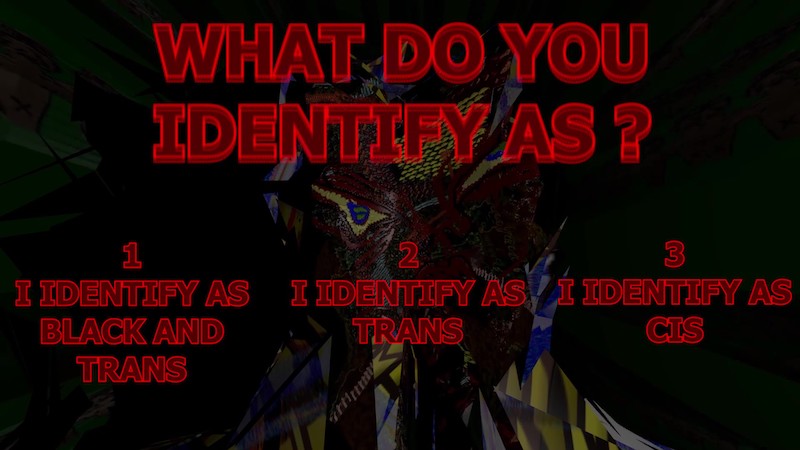
Danielle Brathwaite-Shirley: ‘We are here because of those that are not/Blacktransarchive.com,’ 2020 // Courtesy the artist
JV: You have collaborated with several different artists on, for example, sound design, performances, talks and visuals. Do you have any favorite collaborative projects?
DBS: ‘The BlackTransArchive’ was done with 15 different Black trans people and three Black trans artists who helped me make it. Evan Sedipo helped with landscape conceptualizing, as well as collaging. Together, we made collages with the 15 different people. Jacob V Joyce helped me do character design concepts, which involved group workshops in which everyone got to design their characters on paper sheets. I then implemented all those characters into the game. Tobi Adebajo helped with character development, creating scenarios for all these characters: what they would want to do in this world and how they would centre themselves.
I did the sound design for the dancer Marikiscrycrycry’s show ‘Hotter Than A Pan’. I did the video projections for Travis Alabanza’s ‘Before I Step Outside [You Love Me]’. But, I think my favorite one has been ‘the BlackTransArchive’. I’m also planning a new one. I think with each iteration of what I do, I am planning more participation from my community. When I did ‘the BlackTransArchive’, I realized how much more it gave the work and built the world of the game when you had a room full of 20 people who have had similar experiences to you. It was really good, I can’t wait to do another one.
JV: Could you tell us a bit more about the Black Trans TV project you created during your time in quarantine?
DBS: I had created that during quarantine because I wanted us to be able to speak and talk to each other about what was going on, but that project halted a little bit because, talking to my friends, it was so hard for us to produce anything productive because we had just lost all our jobs, all our security, all our money and then the Black Lives Matter protests started happening, so it became more important to focus on our wellbeing. So that kind of morphed into a new project, which is this entirely new game coming out next year in which people get their own islands—and that’s all I am going to say about it. The viewer will be able to come and, again, depending on the viewer’s choices, can access the islands or not, and how much of the islands they can access will vary depending on what they choose.
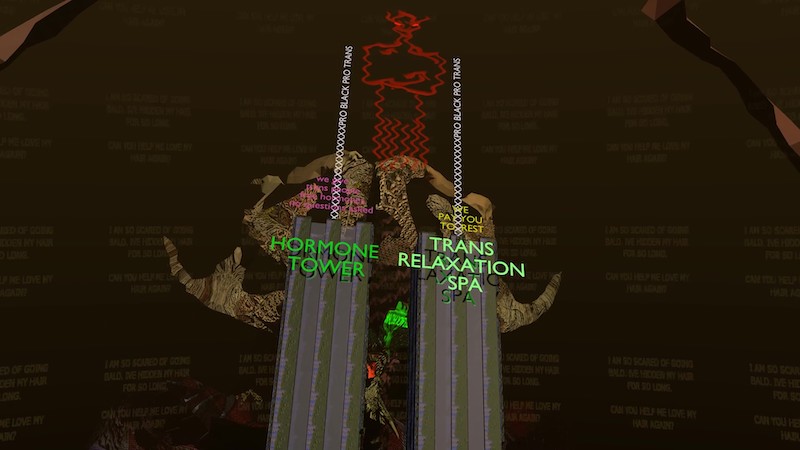
Danielle Brathwaite-Shirley: ‘We are here because of those that are not/Blacktransarchive.com,’ 2020 // Courtesy the artist
JV: As a British artist living in Berlin, how have both places impacted you and your art practice?
DBS: Yeah, it’s been a strange one. Berlin internet is really bad. My practice has moved a lot more online and ever since ‘the BlackTransArchive’ I’ve been way more interested in that. But, making something that works online in Berlin is different, which wasn’t a problem I thought would come up. There is a lot more thought about how to make my file sizes smaller to work over Berlin internet. This basically means I have to be way more inventive with the art I’m using and how everything is presented. My models before were kind of low poly-graphics yet, not enough to be running on this internet. It’s interesting to see how I can make something that references an older generation of games like SNES or Sega Mega Drive or even before PS1 and Nintendo 64 and spread my messages. And now it’s got me thinking what do those games have? How can I use that to make something that tells a story again? That has got me really excited. I am going to reference something old as hell, do you know Game & Watch? Game & Watch were these old games running on these small calculator-like LCD crystal screens, and essentially they screen-print with a liquid crystal and they scrub out the rest. It’s this really old technology that essentially stencils to imagine movement, like a small fun little game. So I’m looking at that kind of technology to create something that tells a story and how effective that can be. The great thing about those games is they are simple, super simple and highly addictive. These spreads kind of look a bit like Kara Walker’s works, she does these kinds of wall outline prints, black silhouettes essentially. Similarly, another great thing Game & Watch does is they work solely with Black silhouettes, which is what I am trying to work with now.
Also, in relation to your question, there are a lot fewer Black trans people in Berlin. Berlin people stare more, a lot more than London, and there seems to be a lot more anti-Black sentiment. So that has been really strange to deal with and see. Colorism is a huge thing in Germany, to be honest, and often the light-skinned people are getting the light shined on them and the darker-skinned, who have been here for a longer time, are not. Coming into that world, I have to ask: how can I uphold my darker skin siblings who have been here, who have been doing the work and have not gotten the appreciation they deserve?
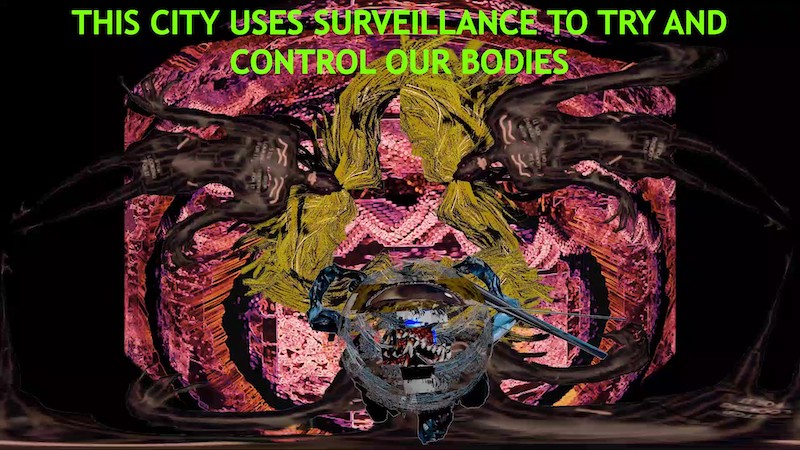
Danielle Brathwaite-Shirley: ‘We are here because of those that are not/Blacktransarchive.com,’ 2020 // Courtesy the artist
JV: A recent Instagram post of yours suggests the possibility of future projects bridging these two cities. Can you give us any sneak peeks into what is to come?
DBS: Yes, I can. So I’m building another interactive archive based on interviews I will be carrying out with other trans people. It will be kind of like World of Warcraft, Habba Hotel or Club Penguin, things like that where interviews will be hosted in the video game realm so you can go online and access such interviews. Essentially, you’ll be playing through soundscapes that, depending on what interview you choose, will change. So it just builds and builds and builds based on choice.
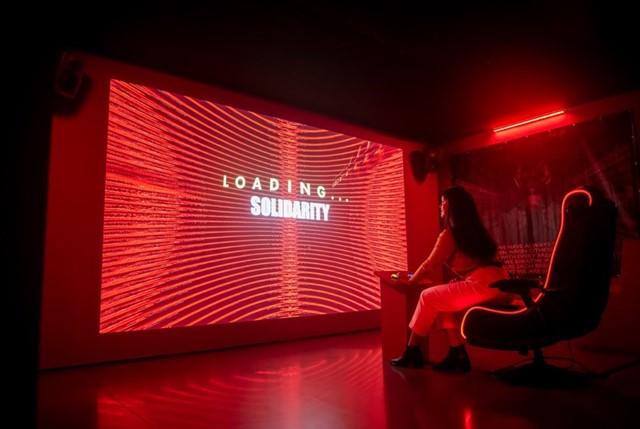
Danielle Brathwaite-Shirley: ‘We are here because of those that are not/Blacktransarchive.com,’ 2020 // Courtesy the artist, photo from the science gallery
I’m also working on a new game I had made during quarantine. I spent three months making this game and then my computer gave up on me but, I still have this game. It’s just not working in the same way. So now, I am turning it into a game film. There will be loads of different versions of this film because there are so many choices in this game. There will be around 15 different versions, so depending on which one is displayed where, it will be a completely different experience of the film. The particular version of the film that is chosen will be dependent on who is asking me to show it. The version will be chosen particularly because you asked me, or this institution asked me. There is also a performance in the works, based on mass audience participation and the end of the performance is determined by who participates and who doesn’t and who is actually in the room.
And there is one final project, which I’m hoping to get funding for, which is creating a kind of Escape Room game experience.
Artist Info
daniellebrathwaiteshirley.com
thepathyouwalk.com
Exhibition Info
Focal Point Gallery
Group Show: ‘To Dream Effectively’
Exhibition: Sept. 13, 2020–Jan. 17, 2021
fpg.org.uk
Elmer Ave, Southend-on-Sea SS1 1NB, UK, click here for map






















